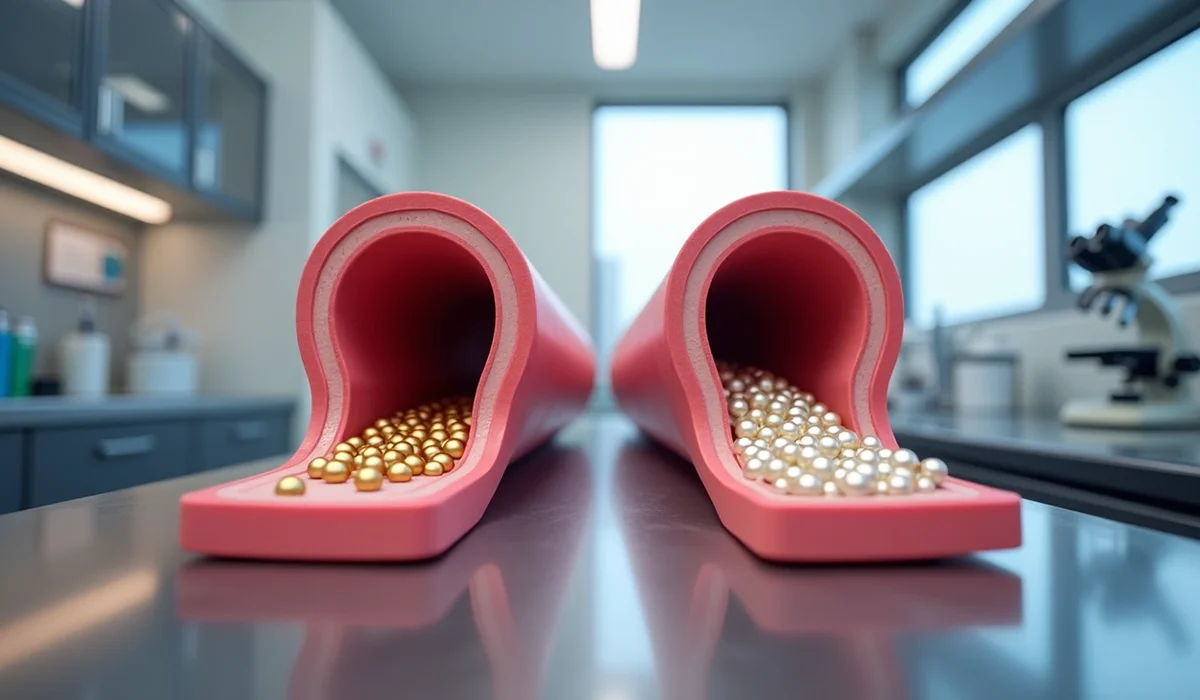Can the difference between HDL and LDL cholesterol be a matter of life and death? You bet it can. More than a third of Americans have high LDL cholesterol that puts them at risk of heart disease. People often talk about cholesterol in general terms, but knowing the difference between “good” and “bad” cholesterol helps you manage your health better.
Your body’s HDL cholesterol, known as “good cholesterol,” works hard to remove LDL (the “bad cholesterol”) from your bloodstream. The numbers tell a concerning story – 26.6% of men and 8.5% of women have low HDL levels that affect their body’s natural cholesterol management. LDL cholesterol builds up in your arteries and leads to atherosclerosis, which can cause heart attacks and strokes. The stats are sobering: 805,000 Americans have a heart attack each year, and 605,000 of these are first-time cardiac events.
This piece breaks down the key differences between LDL and HDL. You’ll learn why balancing good and bad cholesterol matters to your health and what your cholesterol numbers really mean. This knowledge matters now more than ever, as 94 million American adults have total cholesterol levels above 200 mg/dL.
Understanding HDL vs LDL: The Two Types of Cholesterol
Your body uses cholesterol as a basic building block that performs key functions, despite what many think about it. This waxy, fat-like substance exists in every cell to help create cell membranes, hormones, vitamin D, and support digestion [1]. All the same, you need to know the difference between the two main types of cholesterol to keep your heart healthy.
What is cholesterol and why does it matter?
Your liver produces all the cholesterol your body needs, though foods like meat and dairy add more to the mix [2]. Blood can’t dissolve cholesterol directly, so it moves through your bloodstream on proteins called lipoproteins [3]. Your cardiovascular health depends on proper cholesterol management, and with good reason too.
LDL: The ‘bad’ cholesterol explained
Low-density lipoprotein (LDL) gets its bad reputation because it dumps cholesterol in your arteries where it piles up. High LDL levels cause this cholesterol to form plaque on artery walls that narrows blood vessels and limits blood flow [4]. Most adults should keep their LDL below 100 mg/dL [4]. People who already have atherosclerosis want to aim for levels under 70 mg/dL [4].
HDL: The ‘good’ cholesterol explained
High-density lipoprotein (HDL) works like your body’s cleanup crew. HDL does the opposite of LDL – it picks up extra cholesterol from your bloodstream and takes it back to your liver for removal [3]. Your HDL levels should be above 60 mg/dL to lower your heart disease risk [5]. Men need at least 40 mg/dL while women need 50 mg/dL as their minimum healthy threshold [6].
How they work differently in your body
These two types of cholesterol serve opposite roles: LDL delivers cholesterol to your cells and arteries, while HDL removes it from your bloodstream [2]. HDL uses reverse cholesterol transport to clean up after LDL [6]. Your arteries can develop plaque faster without enough HDL to balance out LDL, which might lead to atherosclerosis, heart attacks, and strokes [3]. On top of that, HDL protects your cells and prevents blood clots through its anti-inflammatory benefits [6].
How HDL and LDL Affect Your Health
Your body handles cholesterol differently based on whether HDL or LDL particles carry it through your bloodstream. These lipoproteins work in opposite ways to affect your cardiovascular system, creating a balance that shapes your health.
LDL’s role in plaque buildup and artery narrowing
LDL cholesterol becomes a threat when it builds up in your arteries. The deposited LDL particles can oxidize and trigger inflammation, which draws immune cells to the area [7]. This creates fatty streaks that are the first signs of atherosclerotic plaques [7]. The growing plaque makes your arteries narrow and restricts blood flow [8]. Your heart must work harder to pump blood through these narrow vessels, which raises your blood pressure [9]. A ruptured plaque can create blood clots that might completely block blood flow [8].
HDL’s protective function in removing cholesterol
HDL cholesterol acts as your body’s cleanup crew through reverse cholesterol transport. It picks up extra cholesterol from tissues, including artery walls, and takes it back to the liver for removal [7]. HDL’s benefits go beyond this main task. Its antioxidant properties help prevent LDL oxidation [10]. It also gets more nitric oxide production and thus encourages more circulation [7]. HDL helps regulate blood clotting factors that prevent thrombosis [7].
The link between cholesterol imbalance and heart disease
We noticed that cholesterol imbalance leads to atherosclerosis, which causes several heart problems:
- Coronary artery disease that limits blood flow to heart muscle [9]
- Heart attacks that stop blood flow to part of the heart [8]
- Strokes from blood clots blocking brain blood flow [8]
- Chest pain (angina) due to reduced heart blood flow [8]
Other health conditions affected by cholesterol levels
Cholesterol imbalance affects many other health issues. Diabetes patients’ LDL particles stick to arteries more easily because glucose attaches to lipoproteins [9]. People with type 2 diabetes often develop diabetic dyslipidemia, a condition that affects up to 70% of patients [9]. High cholesterol also plays a role in erectile dysfunction by narrowing the penis’s smaller blood vessels and limiting blood flow [9].
Measuring and Understanding Your Cholesterol Numbers
Knowledge of what these measurements reveal about your health is vital to understand your cholesterol numbers. Your doctor measures several key values that help assess your cardiovascular risk during a standard lipid panel.
Total cholesterol: What the number means
Total cholesterol shows the combined amount of all cholesterol types in your bloodstream. The sum of your LDL, HDL, and 20% of your triglycerides gives you this number [11]. Medical professionals use milligrams per deciliter (mg/dL) to measure cholesterol [11]. A total cholesterol reading below 200 mg/dL shows desirable levels [1]. Values between 200-239 mg/dL indicate borderline high levels, while readings at or above 240 mg/dL show high levels [1]. This number gives us a baseline assessment of your overall cholesterol status.
Healthy ranges for HDL and LDL cholesterol
Most adults should keep their LDL (bad) cholesterol below 100 mg/dL [1]. People with heart disease need even lower levels—below 70 mg/dL [12]. HDL (good) cholesterol works differently – higher numbers benefit you more. Men need HDL levels above 40 mg/dL, while women should reach above 50 mg/dL [12]. Both sexes benefit most from HDL levels of 60 mg/dL or higher, which helps protect against heart disease [13].
The HDL to LDL ratio: Why it matters
The relationship between HDL and LDL cholesterol tells us more than individual measurements alone. Research shows that total/HDL cholesterol and LDL/HDL ratios predict cardiovascular risk better than looking at cholesterol levels separately [14]. Each unit increase in the total/HDL ratio links to a 53% higher heart attack risk [14]. This ratio shows the balance between protective and potentially harmful lipoproteins clearly.
How often you should get your cholesterol checked
Your age, sex, and risk factors determine how often you need testing. Adults between 20-45 (men) or 20-55 (women) usually need screening every five years [3]. Men aged 45-65 and women aged 55-65 should test every 1-2 years [3]. Everyone over 65 needs yearly screening [3]. People with diabetes, heart disease, family history of high cholesterol, or other cardiovascular risk factors might need more frequent checks [15].
Factors That Influence Your HDL and LDL Levels
Your cholesterol profile depends on several factors that affect the balance between HDL and LDL levels. These variations help explain why cholesterol patterns differ among people.
Dietary influences on good and bad cholesterol
What you eat is a vital part of managing your cholesterol. Your “bad” LDL cholesterol levels rise when you eat foods high in saturated fats [4]. You’ll find these fats mostly in:
- Fatty cuts of red meat
- Full-fat dairy products
- Tropical oils (coconut and palm)
Store-bought cookies, crackers, and fried foods contain trans fats that increase overall cholesterol and reduce HDL [6]. Foods rich in omega-3 fatty acids and soluble fiber can enhance your lipid profile [6].
Genetic factors affecting cholesterol balance
Your family history substantially affects your cholesterol levels, with inherited traits accounting for 40-60% [16]. Familial hypercholesterolemia (FH) affects about 1 in 250 people [17]. This happens because their bodies lack the specific protein (LDL receptor) needed to remove LDL from blood [18]. People with FH might not see enough improvement in their cholesterol levels even with perfect eating habits [19].
Age, sex, and hormonal influences
Cholesterol patterns change as you age. Men aged 20-39 have a higher risk of elevated total cholesterol [4]. Women face increased risk after menopause as their estrogen levels drop [4]. Their LDL levels typically increase while HDL levels decrease [4], which creates a concerning lipid profile.
Medical conditions that affect cholesterol levels
Several health conditions change the balance between LDL and HDL. Type 2 diabetes causes LDL particles to stick more easily to arteries [20], and about 70% of patients develop diabetic dyslipidemia [9]. Hypothyroidism leads to higher cholesterol levels, while hyperthyroidism medications can raise cholesterol [20]. Chronic kidney disease, HIV, and PCOS also affect cholesterol levels [20].
Lifestyle factors: Exercise, smoking, and alcohol
Exercise substantially improves your HDL cholesterol levels. You can raise HDL levels with just 30 minutes of moderate activity five times weekly [21]. Smoking harms blood vessels and reduces HDL, especially in women [4]. Moderate alcohol consumption (up to one drink daily for women, two for men) increases HDL levels [4], but drinking too much raises total cholesterol [4].
Conclusion
The difference between HDL and LDL cholesterol is a vital factor in keeping your heart healthy. In this piece, we looked at how these two types of cholesterol work differently in your body. LDL leaves cholesterol in your arteries and can lead to dangerous plaque buildup. HDL works like your body’s cleanup crew by removing extra cholesterol and taking it to your liver to be eliminated.
Your cholesterol numbers reveal a lot about your heart’s health. You should try to keep your LDL below 100 mg/dL. HDL should stay above 40 mg/dL for men and 50 mg/dL for women. The relationship between these numbers gives better insight into your heart health risks than looking at either one alone.
Many things affect your cholesterol balance. Your diet definitely plays one of the most important roles. Saturated and trans fats raise LDL levels, while omega-3 fatty acids and soluble fiber help improve your overall numbers. Your genes, like familial hypercholesterolemia, can also affect how you manage cholesterol. Your age, hormone changes, health conditions, and lifestyle choices all shape your unique cholesterol pattern.
Everyone needs regular cholesterol screening, especially when you have risk factors like family history, diabetes, or heart disease. Most adults should check their cholesterol every five years. You might need more frequent checks as you age or develop additional risk factors.
Now that you understand HDL and LDL cholesterol better, you can make smarter choices about your diet, exercise, and medical care. These two types of cholesterol are so different that keeping them balanced isn’t just about numbers – it could save your life.
References
[1] – https://www.hopkinsmedicine.org/health/treatment-tests-and-therapies/lipid-panel
[2] – https://www.healthline.com/health/hdl-vs-ldl-cholesterol
[3] – https://medlineplus.gov/cholesterollevelswhatyouneedtoknow.html
[4] – https://www.nhlbi.nih.gov/health/blood-cholesterol/causes
[5] – https://www.health.harvard.edu/blog/understanding-cholesterol-hdl-vs-ldl-2018041213608
[6] – https://www.mayoclinic.org/diseases-conditions/high-blood-cholesterol/in-depth/reduce-cholesterol/art-20045935
[7] – https://pmc.ncbi.nlm.nih.gov/articles/PMC10724412/
[8] – https://www.mayoclinic.org/diseases-conditions/high-blood-cholesterol/symptoms-causes/syc-20350800
[9] – https://www.webmd.com/cholesterol-management/diseases-linked-high-cholesterol
[10] – https://www.ahajournals.org/doi/10.1161/01.cir.0000131512.50667.46
[11] – https://my.clevelandclinic.org/health/articles/11920-cholesterol-numbers-what-do-they-mean
[12] – https://www.nhlbi.nih.gov/health/blood-cholesterol/diagnosis
[13] – https://www.health.harvard.edu/staying-healthy/a-closer-look-at-good-cholesterol
[14] – https://pmc.ncbi.nlm.nih.gov/articles/PMC2747394/
[15] – https://www.healthline.com/health/high-cholesterol/levels-by-age
[16] – https://pmc.ncbi.nlm.nih.gov/articles/PMC2903789/
[17] – https://www.cdc.gov/cholesterol/risk-factors/index.html
[18] – https://health.clevelandclinic.org/is-high-cholesterol-genetic
[19] – https://www.hopkinsmedicine.org/health/conditions-and-diseases/high-cholesterol/what-to-do-when-high-cholesterol-runs-in-your-family
[20] – https://my.clevelandclinic.org/health/articles/11918-cholesterol-high-cholesterol-diseases
[21] – https://www.heart.org/en/health-topics/cholesterol/prevention-and-treatment-of-high-cholesterol-hyperlipidemia





